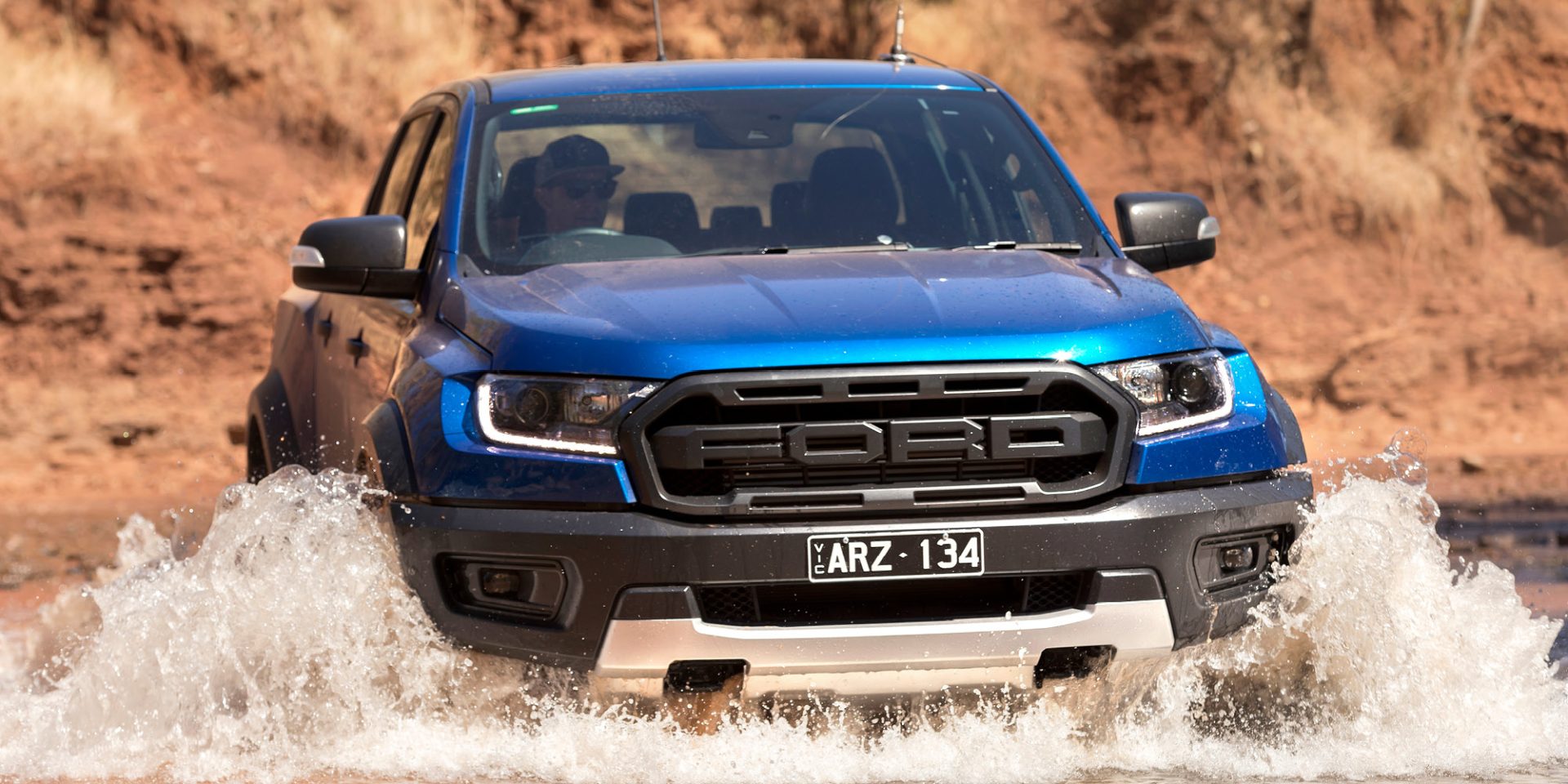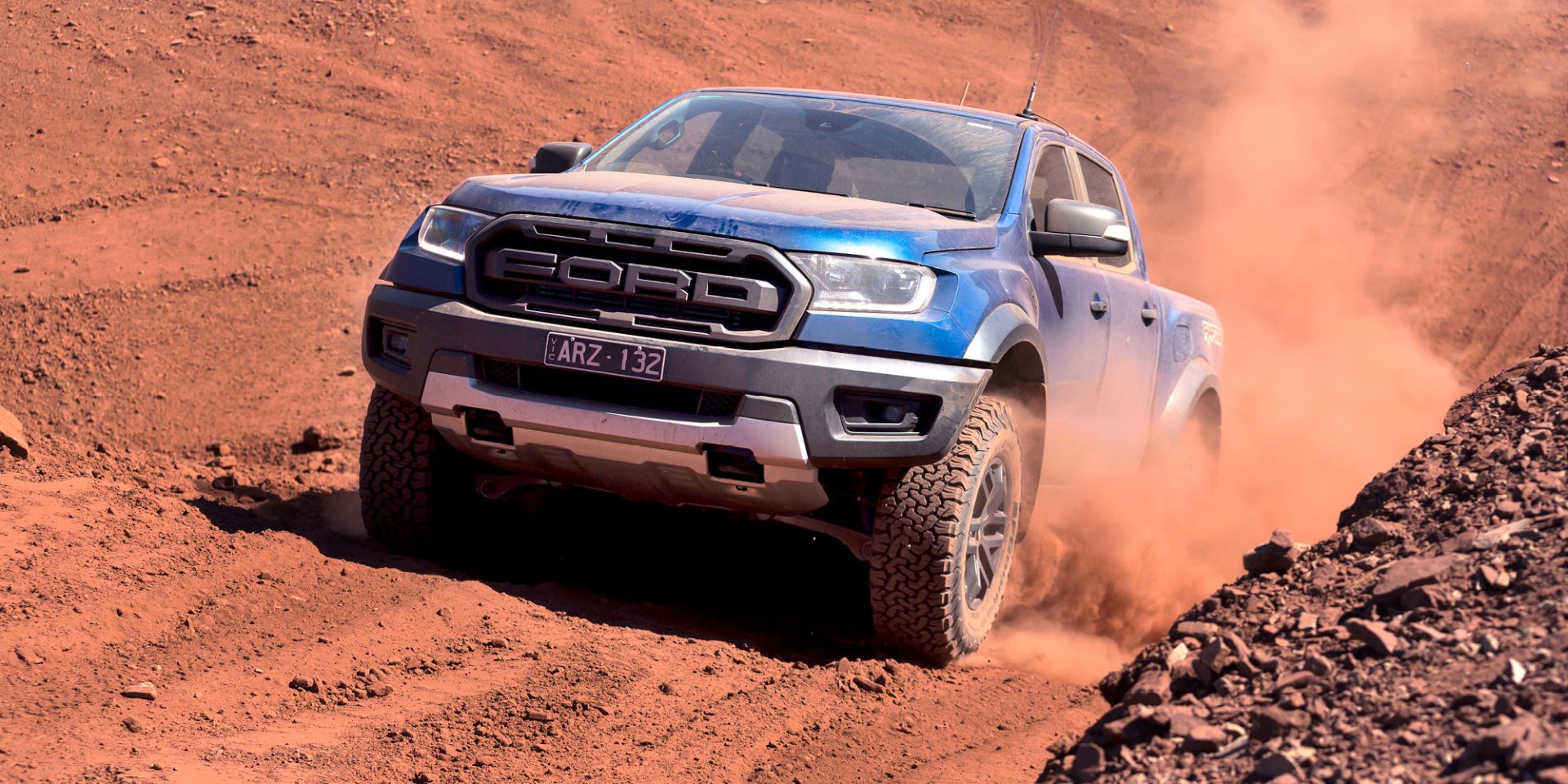Does the 2.0-litre engine cut the mustard?
It’s quite easily one of the most talked about new vehicles coming to Australia in the past few years: The Ranger Raptor. Following on from the F-150 Raptor stateside that has built a reputation as a serious (and seriously fast) performance ute, Ford are looking to cash in on the cache of kudos with a Ranger-based ute. We already know it’s going to have internal bypass shocks, 33-inch all-terrains, discs and coils all-round, as well as improved ground clearance and a much-widened wheel track. What’s less impressive is the 157kW/500Nm 2.0-litre twin turbo engine, running through a 10-speed gearbox. It’s heavier, the tyres increase the gearing, and the payloads and towing capacity have taken a hit.
CLICK HERE TO READ THE ROADTEST IN OUR ONLINE MAGAZINE
Robert Pepper was on the ground to drive the Ranger Raptor in Darwin recently. And while he was still wiping the bulldust from his brow at the airport, we asked him the hard questions.
Q. How does the Raptor drive on-road?
A. Superbly, in all dimensions. It’s the best of any ute … except it lacks power. It doesn’t feel as powerful as the 3.2-litre Ranger, and is way behind the likes of the V6 Amarok.
Q. How does it drive off-road, both in terms of fast and low speed stuff?
A. Low-speed performance is brilliant, probably the best of any ute. This is thanks to the increased ground clearance, wider wheel track, bigger tyres and rear locker. The only downsides are more width (less maneuverability) and while it has improved, Ford’s brake traction control is still below par.
High-speed off-road performance is amazing. It feels like a comp truck, but again, you feel the lack of power. The way the Raptor soaks up bumps is amazing; it’s buggy-like.
Q. Tell me more. What made it so good at high speed off-road?
A. The suspension. First, it’s long-travel. Then it’s got a soft, plush centre on the shocks so you really feel all four wheels are easily soaking up small bumps. The way the shocks just cancel out big hits, thanks to position-sensitive damping, is amazing. You can lift all four wheels off the ground and not feel a jolt when you land: my backside was puckering up but the hit never came. Add in the taller tyres and wider tracks … and you have an amazing off-road machine. It is confidence-inspiring, and a lot of fun. It went quickly, but I really wanted more laps to get into it.

Q. What course did you get to drive?
A. It took about six minutes, and topped out at 140km/h. It was a dirt-road track, not a wide gravel road, narrow at times, rutted, chopped up and full of bulldust in places. It was good little run for the car; there were no big hills which would have shown the lack of power under the bonnet. It was also representative of outback/off-road touring conditions.
Q. It’s billed as a go-fast fun machine, but we reckon it needs to be a few other things as well. Do you see it working as a 4WD touring 4X4? I’m imagining a canopy, lightweight storage setup, dual batteries, extra fuel and water storage, a couple of swags, and a fridge.
A. The problem is weight carrying. Because of its high-speed focus you can’t carry much (686kg payload, vs 907kg in Wildtrak). So, it won’t work for a family of four. If you’re two-up and travel light then yes, it’d be great. But, I’d keep the accessories and weight to a real minimum on this one, and don’t touch the suspension!
Q. What about operating a Raptor as a family chariot?
A. As a day-to-day car, it’d be a slight pain in the backside at the shops due to width and the turning circle, and it’s not exactly going to be nimbly zipping away from the traffic lights …
Q. What about price. An automatic Wildtrak currently costs $61,790 plus on roads. Is the Raptor worth the additional $14,000?
A. Yes, if you want to drive off-road at high speed unloaded. You’re getting a bunch of extras: rated front/rear recovery points, wheels, tyres, suspension, towbar. This is all gear you’d want to buy for your Wildtrak. Put all that in perspective, and the $14k price difference narrows a lot.
Q. Everybody loves to hate the 2.0 litres of engine capacity. It uses two turbos to make 157kW and 500Nm; is it enough engine for the rest of the car?
A. Sadly, no. It’s not. I think the Raptor needs 200kW and 600Nm. It’s funny, you can never tell how a car drives by the spec sheet. Defenders, for example, drive way quicker than you’d expect from 90kW.

Q. And how they look, right? Imagine asking somebody about 10-speed gearboxes that wasn’t a Road Ranger back in the 90s, they’d probably think you’re high as a kite. How does the new gearbox perform? Is it a confused mess?
A. No, it does a good job. But it doesn’t respond to commands when it should. For example: refusing to downshift when at 3000rpm. You can’t remember which gear you’re in so you just have to leave it in Drive and trust it to do the job, which it does best as it can.
Q. Is the exterior metalwork functional for off-road and bushability?
A. Yes. The front guards are SMC (sheet-moulding compound), which is a lighter, more durable material of plastic/metal than just steel. The sidesteps are actually designed to take the vehicle’s load, and there’s functional underbody protection.
Q. Superior Engineering do a five-link coil conversion on a Ranger for $6200, drive in, drive out. Add some bypass shocks, good rubber, and bang that track out via wheel offset. Plus, remap the 3.2 for more poke. Would you consider that, instead of paying the $75,000 for a Raptor?
A. Yes, I would. You could buy a secondhand Ranger for example and do that to it. I don’t like the idea of increasing track via wheel offset as there’s all sorts of issues with that, but even if the end result isn’t as good as a Raptor, it might be good enough and less compromised on load carrying and power.
Q. Would you fit 35s if you owned one? Or would that ruin it?
A. It’d ruin it, massively changing the unsprung mass, losing the specialist tyres, changing all the gearshift, electronics calibration. Just don’t do it, 35s are not the answer to every problem! I wouldn’t change anything really. It’d be like buying a Ferrari and swapping to an LS3.
Q. That, uh, kind of sounds cool. What do you mean about specialist tyres?
A. Yes, they are a specific compound and carcass design for the Raptor, developed with Michelin and Ford engineers working side-by-side. They tested eight options before coming up with the final product, which matched exactly to the suspension, wheels and vehicle. The testing started with computer simulations and ended in the field, and the results are fantastic. The Raptor would work with standard KO2s, but that final little edge of performance wouldn’t be there.

Q. Your three most favourite things about Raptor?
A. High-speed off-road handling (maybe I should make that one, two and three!), low-range ability, and the fact it comes in a practical ute body with all the Wildtrak features (minus some safety stuff).
Q. Aaaaaand, your three least favourite things about Raptor?
A. Three Ps, in order – power, price, payload. It needs more power, no getting around that one. The price is a little high and payload is too low. I can forgive the last two, but there’s no excuse for the first.
Funny you mentioned an LS3 before, right?










